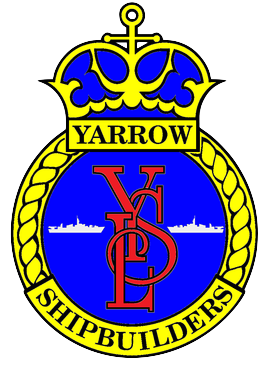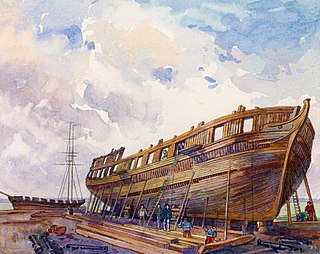
A shipyard, also called a dockyard or boatyard, is a place where ships are built and repaired. These can be yachts, military vessels, cruise liners or other cargo or passenger ships. Compared to shipyards, which are sometimes more involved with original construction, dockyards are sometimes more linked with maintenance and basing activities. The terms are routinely used interchangeably, in part because the evolution of dockyards and shipyards has often caused them to change or merge roles.

Yarrow Shipbuilders Limited (YSL), often styled as simply Yarrows, was a major shipbuilding firm based in the Scotstoun district of Glasgow on the River Clyde. It is now part of BAE Systems Surface Ships, owned by BAE Systems, which has also operated the nearby Govan shipyard since 1999.
Bathurst Street Wharf was a series of shipyards located in Toronto, Ontario, Canada, between Bathurst Street and Spadina Avenue along Lake Shore Boulevard West.
Toronto Drydock Company is a shipbuilding repair company in Canada and the name of two shipbuilders in the 19th and 20th centuries respectively.

HMCS Messines was one of twelve Battle-class naval trawlers constructed for and used by the Royal Canadian Navy (RCN) during the First World War. Following the war the ship was transferred to the Canadian Department of Marine and Fisheries and converted into a lightvessel. Re-designated Lightship No. 3, the vessel was sold for scrap and broken up in 1962.

HMCS St Julien was one of twelve Battle-class naval trawlers constructed for and used by the Royal Canadian Navy (RCN) during the First World War. Following the war the ship was transferred to the Canadian Department of Marine and Fisheries and converted into a lightvessel. Re-designated Lightship No. 22, the ship remained as such until 1958. The ship was sold for commercial use and renamed Centennial and was in service until 1978.

The Battle-class trawlers were a class of naval trawlers built for and used by the Royal Canadian Navy (RCN) during the First World War. Between the wars, some remained in RCN service, but most were transferred to the Department of Marine and Fisheries, where they performed a number of functions, including working as lightships and fisheries patrol vessels. During the Second World War, a number of these trawlers were re-acquired by the RCN, but all the navy's Battle-class trawlers were decommissioned soon after the war. A number of the class remained in civilian government and commercial service for years after the war, although most had been disposed of by the early 1960s.

The Naval Shipyards were naval shipbuilding facilities used by the Provincial Marine and the Royal Navy in York, Upper Canada. The naval shipyards were ordered by the Lieutenant Governor of Upper Canada John Graves Simcoe in 1793, and were opened in 1798.
Canadian Vickers Limited was an aircraft and shipbuilding company that operated in Canada during the early part of the 20th century until 1944. A subsidiary of Vickers Limited, it built its own aircraft designs as well as others under licence. Canadair absorbed the Canadian Vickers aircraft operations in November 1944.

Harlan & Hollingsworth was a Wilmington, Delaware, firm that constructed ships and railroad cars during the 19th century and into the 20th century.

Neafie, Levy & Co., commonly known as Neafie & Levy, was a Philadelphia, Pennsylvania shipbuilding and engineering firm that existed from the middle of the 19th to the beginning of the 20th century. Described as America's "first specialist marine engineers", Neafie & Levy was probably the first company in the United States to combine the building of iron ships with the manufacture of steam engines to power them. The company was also the largest supplier of screw propellers to other North American shipbuilding firms in its early years, and at its peak in the early 1870s was Philadelphia's busiest and most heavily capitalized shipbuilder.
James Playfair was noted for his entrepreneurship in the Great Lakes shipping, lumbering, grain handling, and industrial manufacturing businesses. He was a central figure in the establishment of Midland, Ontario, Canada. The son of John Speirs Playfair and Georgina Hall of Montreal, in 1889 Playfair married Sarah Charlotte Ogilvie (1858-1945), youngest daughter of Senator A.W. Ogilvie of Montreal, former president of Ogilvie Flour Mills.

The Morgan Iron Works was a 19th-century manufacturing plant for marine steam engines located in New York City, United States. Founded as T. F. Secor & Co. in 1838, the plant was later taken over and renamed by one of its original investors, Charles Morgan.

The Great Lakes Engineering Works (GLEW) was a leading shipbuilding company with a shipyard in Ecorse, Michigan, that operated between 1902 and 1960. Within three years of its formation, it was building fifty percent of the tonnage of all ships in the Great Lakes. During World War II, GLEW was commissioned by Pittsburgh Steamship Company and the U.S. Maritime Commission to build twenty-one ore freighters. Its innovations included the first self-unloader freighter, SS Wyandotte. GLEW is best known for its construction of the SS Edmund Fitzgerald.

The Polson Iron Works was an Ontario-based firm which built large steam engines, as well as ships, barges and dredges.

Dialogue & Company was a shipbuilding firm located in the Port of Camden on the Delaware River in New Jersey. It was founded by John H. Dialogue.
Reaney, Son & Archbold was a 19th-century American iron shipbuilding company located on the Delaware River at Chester, Pennsylvania. The company was established in 1859 by Thomas Reaney but it was undercapitalized from the outset, and like many other American shipbuilding companies, fell victim to the shipbuilding slump that followed the American Civil War.
The Delaware River Iron Ship Building and Engine Works was a major late-19th-century American shipyard located on the Delaware River in Chester, Pennsylvania. It was founded by the industrialist John Roach and is often referred to by its parent company name of John Roach & Sons, or just known as the Roach shipyard. For the first fifteen years of its existence, the shipyard was by far the largest and most productive in the United States, building more tonnage of ships than its next two major competitors combined, in addition to being the U.S. Navy's largest contractor. The yard specialized in the production of large passenger freighters, but built every kind of vessel from warships to cargo ships, oil tankers, ferries, barges, tugs and yachts.
Lawrence & Foulks was a 19th-century American shipbuilding company based in New York. Established in the early 1850s, the company built 144 vessels of all types over the course of some fifty years, but is best known for its production of high-speed wooden-hulled steamboats and steamships. Notable vessels built by the company include the record-breaking Hudson River steamboat Chauncey Vibbard, the luxury Long Island Sound steamer Commonwealth, and the fast oceangoing steamships—later U.S. Navy gunboats—Bienville and De Soto. In addition to the domestic market, the company also built ships for service as far afield as South America and China.
Joseph Salter was a Canadian businessman and politician, becoming Moncton’s first mayor and one of the leading shipbuilders in the Maritime Provinces. As a young man employed by John Leander Starr of Halifax, Salter crossed the Atlantic 36 times. He later built some of the finest and largest ships in Westmorland County. He kept a diary which was published in 1996.













